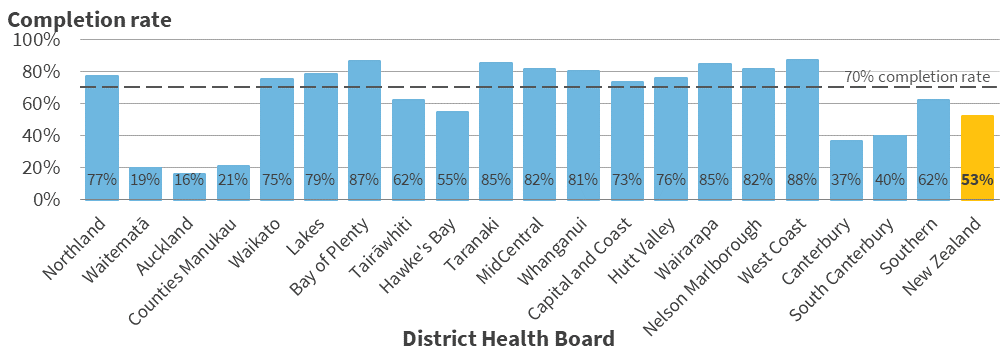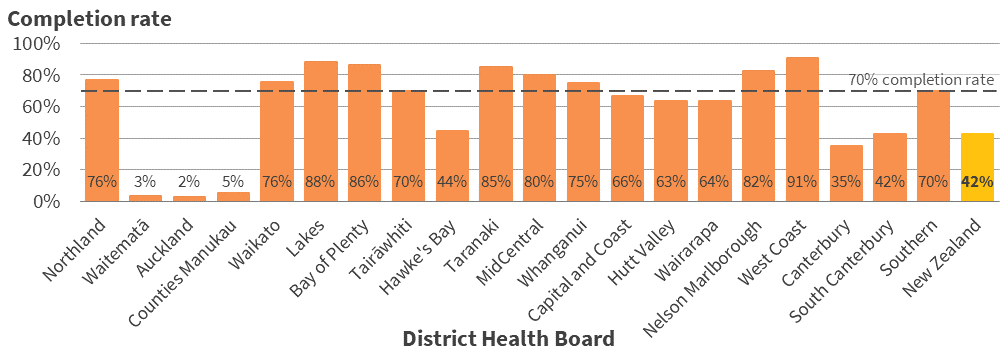Water-borne diseases related to drinking-water
This section presents statistics on three potentially water-borne diseases in Aotearoa New Zealand: campylobacteriosis, giardiasis and cryptosporidiosis.
These gastrointestinal diseases cause symptoms like diarrhoea and vomiting. Contaminated recreational water is one way that people may contract these diseases. Other ways include contact with drinking water, farm animals, sick animals, faecal matter, other symptomatic people, and eating contaminated food.
Background information
Campylobacteriosis, giardiasis, and cryptosporidiosis are gastrointestinal diseases caused by Campylobacter bacteria, Giardia parasite, and Cryptosporidium parasite infection, respectively. These diseases may be transmitted through contact with the faeces of infected animals and humans, either through ingesting contaminated food or water or by contact with infected beings.
Poultry was once considered the primary source of campylobacteriosis in New Zealand, with poultry-associated strains of Campylobacter more likely to be found in urban than rural areas (Mullner et al, 2010). However, food-related interventions led to more than a 50% decrease in cases in 2008 (Sears et al, 2011; ESR, 2017). Other transmission routes such as untreated drinking water or contaminated recreational water bodies are relatively minor sources of campylobacteriosis (Gilpin et al, 2013). However, as food-borne campylobacteriosis cases decrease, these transmission vectors may become more prominent over time.
Waterborne disease notification rates related to drinking untreated water
In 2019, there were 537 notifications of campylobacteriosis, 211 notifications of giardiasis, and 140 notifications of cryptosporidiosis that reported drinking untreated water during the incubation period.
However, risk factor information was only collected for a proportion of notifications, so these numbers may be an underestimate. Risk factor information was collected for only 30.6% of campylobacteriosis notifications, 41.9% of giardiasis notifications, and 41.6% of cryptosporidiosis notifications. Risk factor completion rates varied substantially by District Health Board.
In 2015–19, the following District Health Boards (DHBs) had higher rates of campylobacteriosis, giardiasis and/or cryptosporidiosis with a risk factor of drinking untreated water:
- Hawke's Bay DHB
- Northland DHB
- Wairarapa DHB
- Tairāwhiti DHB
However, low completion rates for risk factor information in many DHBs suggest the rates presented in the 'Notifications of potentially waterborne disease with recreational water as a risk factor' Surveillance report are likely to be underestimates (Figure 3a-c).
Figure 3a: Risk factor completion rate for campylobacteriosis notifications, by DHB, 2015–19

Figure 3b: Risk factor completion rate for cryptosporidiosis notifications, by DHB, 2015–19

Figure 3c: Risk factor completion rate for giardiasis notifications, by DHB, 2015–19

Source: ESR 2020
References
- Duncan, G. 2014. Determining the health benefits of poultry industry compliance measures: the case of campylobacteriosis regulation in New Zealand. New Zealand Medical Journal 127(1391): 22–37.
- ESR. 2021. Notifiable diseases EpiSurv data extraction. Porirua: Institute of Environmental Science and Research Limited. (personal communication with ESR Senior Analysts)
- New Zealand Food Safety. 2019. Annual report concerning Foodborne Disease in New Zealand 2018. Ministry for Primary Industries
- ESR. 2020. Notifiable diseases EpiSurv data extraction. Porirua: Institute of Environmental Science and Research Limited. (personal communication with ESR Senior Analysts)
-
Gilpin B, Walshe G, On S, Smith D, et al. 2013. Application of molecular epidemiology to understanding campylobacteriosis in the Canterbury region of New Zealand. Epidemiol Inf 141(6): 1253–66.
-
Mullner P, Shadbolt T, Collins-Emerson JM, Midwinter AC, et al. (2010). Molecular and spatial epidemiology of human campylobacteriosis: source association and geneotype-related risk factors. Epidemiol Infect 138:1372-1383.
-
ESR. 2017. Notifiable Diseases in New Zealand: Annual Report 2016. Porirua: Institute of Environmental Science and Research. https://surv.esr.cri.nz/PDF_surveillance/AnnualRpt/ AnnualSurv/2016/2016AnnualNDReportFinal.pdf (Accessed 2019).
